This country, which Odin, Willie and Ve made for themselves, after which Odin inhabited it with his sons (Asami), rare inhabitants of other worlds (Nyord, Freyr and Freya from the Vani, Loki from the Giants), as well as the souls of warriors who died with a sword in his hands. The latter reside in Valhalla and await the final battle. Ases are the gods who send protection to Earth for people from giants, they also monitor the life of mankind. One of the main differences between the Viking religion and others is the existence of negative qualities in the gods. They are no longer considered infallible, as, for example, God among Christians, are not absolutely good, as among the Chinese, and bear (albeit in the future) responsibility for their atrocities, unlike the Greek Olympians.
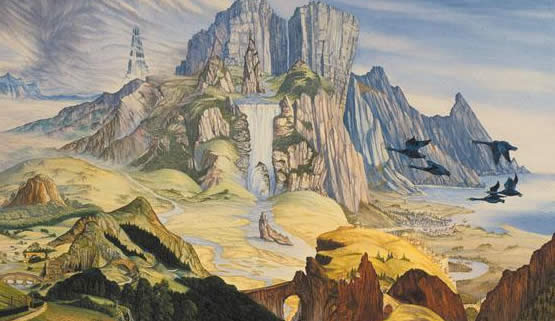
High, high above the clouds, so high that not even the most keen-sighted person can see it, lies the beautiful land of the gods Asgard. The thin but strong Bifrest Bridge - people call it a rainbow - connects Asgard with the earth, but it will be bad for those who dare to climb it. The red stripe that stretches along is an eternal, never extinguishing flame. Harmless to God, it will burn any mortal who dares to touch it.
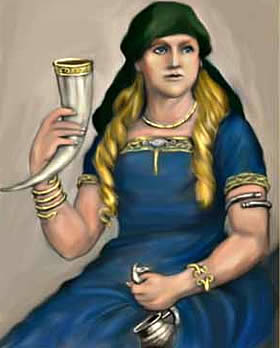 We have already said that Thor's wife, the goddess of fertility Sif, is inferior in beauty to only Freya and is famous throughout the world for her wonderful hair. Now we will tell you how she got them.
We have already said that Thor's wife, the goddess of fertility Sif, is inferior in beauty to only Freya and is famous throughout the world for her wonderful hair. Now we will tell you how she got them.
Once in the old days, Seth had long blond hair, which she was very proud of, but once Loki, out of envy of Thor, sneaked up to her at night and shaved the sleeping goddess bald. The insidious god had not yet gone far when Seth had already woken up and, noticing the loss of her hair, with a loud cry began to call on Thor. Rushing to the call and seeing the shaven head of his wife, the thunder god could not recover from surprise for a long time, but then he realized what was the matter, and then his surprise was replaced by rage. It was not difficult for Thor to guess who played such a cruel joke with Sif, and he immediately rushed to look for Loki.
Gudrun did not follow Sigurd to the stake, as Brunhild did. The first days she cried bitterly for her husband, but then gradually calmed down and even made peace with her brothers, forgiving them his death. And two months later, ambassadors from Atli arrived at the Gyuking castle: the formidable ruler of the Huns wooed the victor's widow Fafnir.
I'm surprised at you, brother! - said Gudrun when Gunnar conveyed this message to her. - Is it worthy for the daughter of Gyuka and the widow of Odin's descendant to marry a Hun? Or do you want to get rid of me, as you got rid of my husband? Why did you not immediately refuse Utle's messengers?
![]()
Once, this was even before the giants began a war with the Asami, the fire god Loki, wandering around the world, wandered into Jotunheim and lived there for three years with the giantess Angrboda. During this time, she bore him three children: the girl Hel, the snake Jormundgad and the wolf cub Fenris. Returning back to Asgard, the fire god did not tell anyone about his stay in the land of giants, but the omniscient Odin soon learned about the children of Loki and went to the source of Urd to ask the prophetic norns about their future fate.
Not more than a year has passed since the wedding of Sigurd and Gudrun, when old Gyuki fell seriously ill and a few days later died quietly in the arms of his sons and daughter. Kriemhild had died even before him. Before her death, she ordered to call her favorite Gutthorn to her and talked about something with him for a long time, after which he became even more secretive than before.
As the eldest son, Gunnar inherited all the property of the king and was proclaimed king, but his friendship with Sigurd did not weaken from this and he still did not let him go.
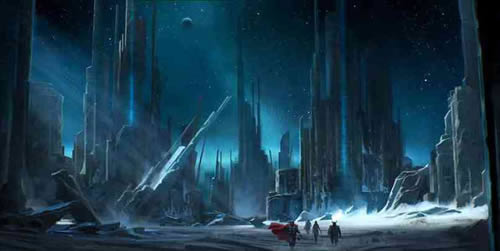
The inhabitants of this world are second in chronology after the Fire and Snow Giants. After the blocks of ice of Niflheim collided with the sparks of Muspelheim's life, the Giant Ymir arose. Then there was still no solid ground, and where Ymir was located is a somewhat unclear question, apparently, he, like his children and unliving blocks of ice, was in the void. Another thing is important - Ymir gave rise to the family of giants and built the world at will. Ymir and his descendants ate the milk of the cow Audumbla, which licked the ice blocks. After Odin, Willie and Ve - the first of the Ases - killed Ymir, his whole world drowned in blood. Only a couple of giants escaped, the descendants of which then inhabited their country.
Higher gods in Germanic scandinavian mythology were called asses and lived in Asgard - a country located in heaven. Odin was considered the eldest god. Besides Odin, there were twelve gods: Thor, Balder, Tyr, Heimdall, Bragi, Hod, Vidar, Vali, Ull, Njord, Freyr, Loki. The main female characters of Scandinavian mythology are Frigg (Odin's wife, who knows fate), Freya (goddess of love), Idunn (keeper of golden rejuvenating apples), golden-haired Siv (wife of the thunder god Thor, presumably associated with fertility) and other Asses were constantly at enmity with Yotunam (giants). At one time the Ases were at enmity with the Vani (gods of fertility).
One
Odin (or Wotan, Óðinn, Odin, Wodan) - the supreme god in the Germanic-Scandinavian
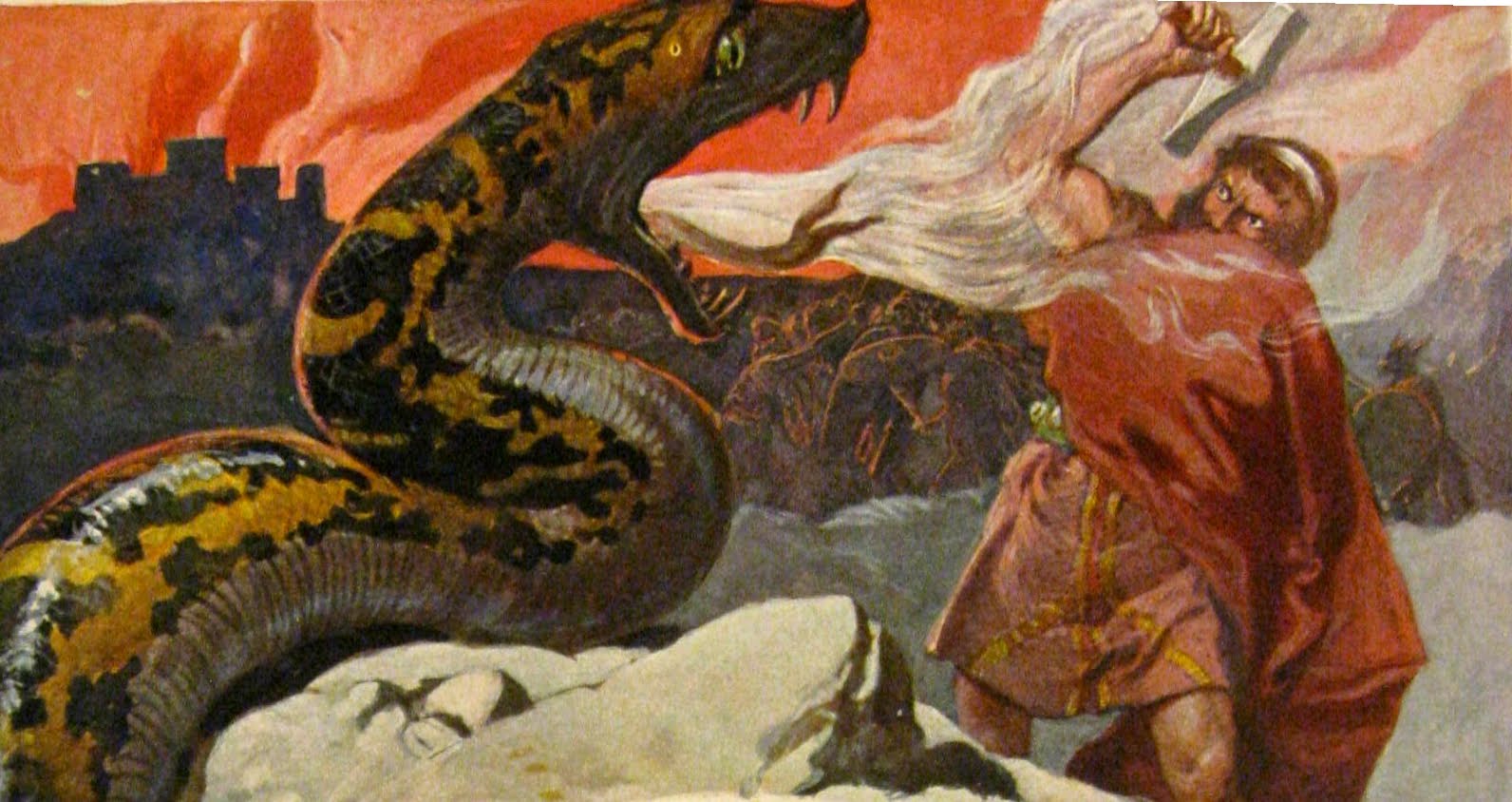
mythology, father of the Aesir. God of war and victory, consort of Frigg. The ancient Romans identified him with Mercury / Hermes. A sage and shaman, an expert on runes and legends, but at the same time, the god of the military aristocracy, the master of Valhalla and the ruler of the Valkyries. One did not need food: he never eats, but lives only by drinking honey or mash.
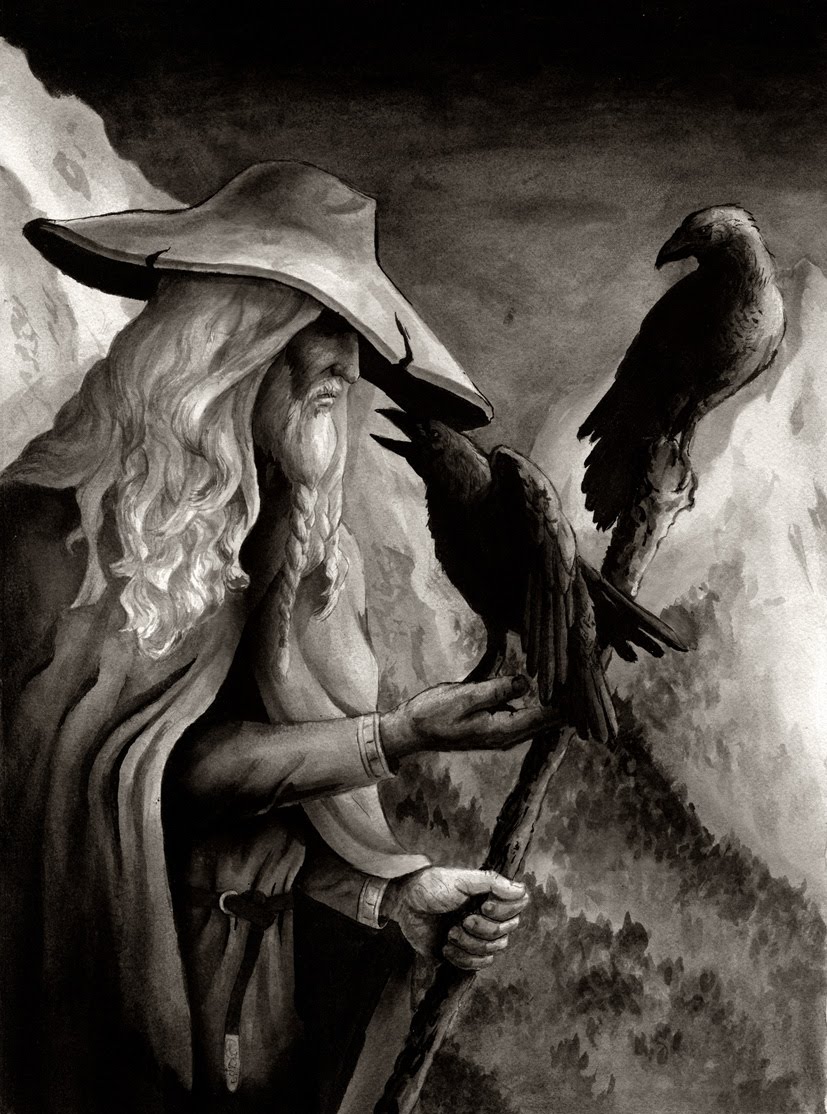
According to legend, he appeared to people most often in the form of a one-eyed old man (Odin gave his right eye to Mimir to drink from a source of wisdom) in a blue cloak and a felt hat, accompanied by two ravens or two wolves, armed with a spear. It was believed that under the guise of a poor wanderer he wanders all over the world, and it will be bad for those who, forgetting the laws of hospitality, push him away from his doorstep. The inhabitants of Scandinavia believed that he often travels around the land on his horse or, invisible to people, takes part in their battles, helping the most worthy to win.
Odin's companions are the ravens Huginn and Muninn (Huginn, Muninn;
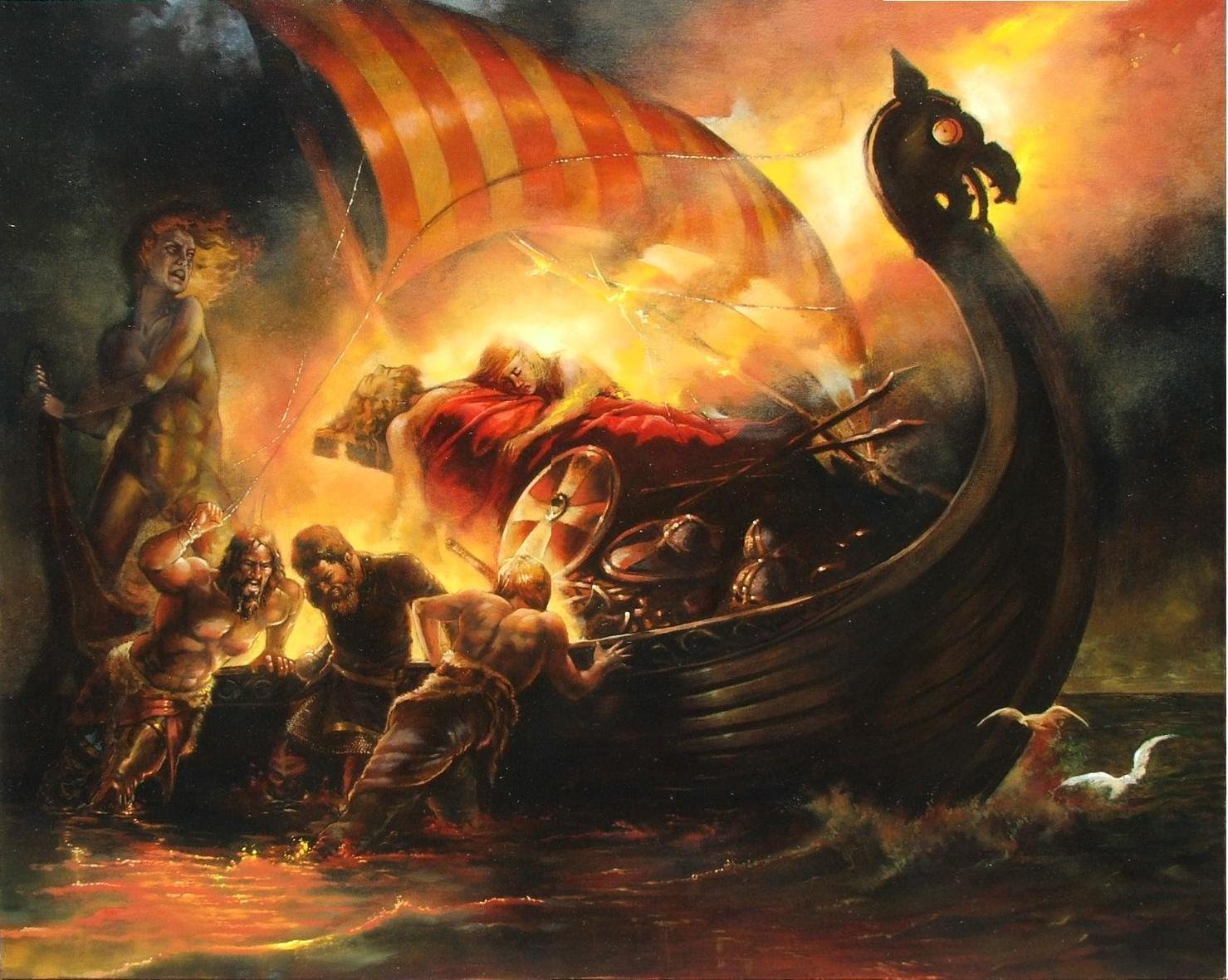
"Thinking" and "remembering") and the wolves Gehry and Freki ("greedy" and "voracious"), his mount is the eight-legged horse Sleipnir (Sleipnir, "sliding"). In Odin's right hand is the Gungnir spear, it never flies past the target and strikes to death anyone it hits. His ship was Skíðblaðnir ("made of thin planks"), which could be folded into a purse if needed, and which was the fastest ship.
In the legends, Odin appears under many names and nicknames. This is due to the traditions of skaldic poetry, where poetic synonyms are accepted - heiti and indirect references to the subject - kennings. Here are some of the names of Odin - Alföðr (Alfödr - "all-father"), Ygg (Ygg - "terrible"), Hár (Har - "high"), Veratýr (Veratur - "the ruler of people"), Bölverkr (Bölverk - "villain" ). The list of names is given in one of the chapters Elder Edda - "Speeches of Grimnir"
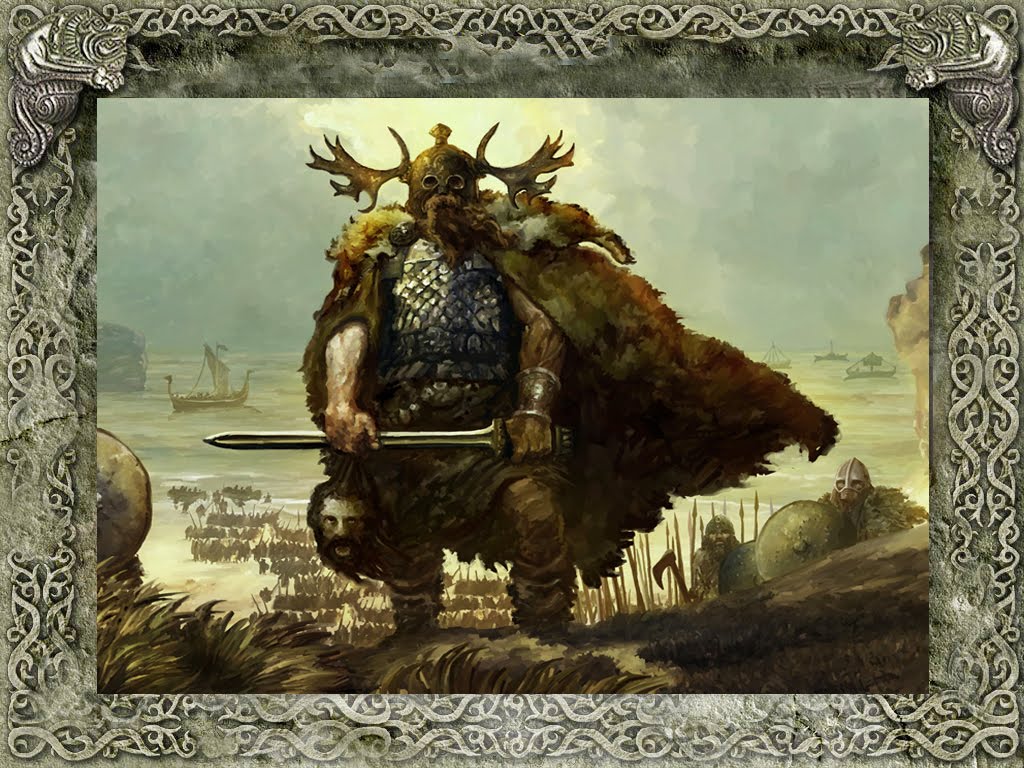
Thor
Thor (Þórr, Thor, Thunar, Donar) - in German-Scandinavian mythology, one of the aces, the god of thunder and lightning, the "thrice-born" eldest son of Odin and the goddess of the earth Yord, the son of Odin and Fjörgun, as well as Odin and Frigg. Thor in Germanic-Scandinavian mythology is the god of thunder, storms and fertility. He was one of the sons of the supreme god Odin and the earth goddess Yord or Fjørgun.
The name of the god's warhammer, Mjöllnir, may once have meant the word "lightning". It is impossible not to notice that Thor, the worst enemy of the giants, had a lot in common with them. The red-bearded hero was very energetic and had an incredible appetite - he ate a bull in one sitting. Thor loved to measure strength with everyone.

His huge bronze chariot was dragged across the sky by two goats named Tangniostr ("grinding teeth") and Tangrisnir ("grinding teeth"). Thor's magical equipment included a hammer (battle ax-lightning), iron mittens, without which it was impossible to hold the handle of a red-hot weapon, and a belt that doubled the strength. The Mjöllnir hammer, forged for God by the dwarf brothers (zwergs), a symbol of creative and destructive forces, a source of fertility and good luck, had a massive striker, a short handle and always hit the target.
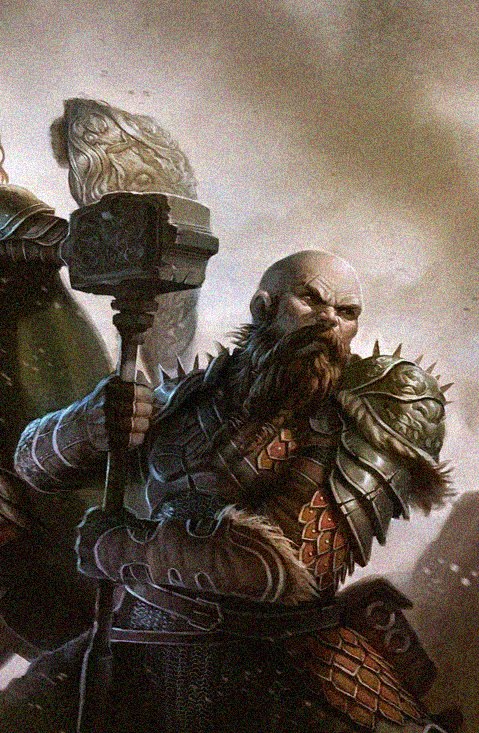
With a red-hot hammer and a belt of power, Thor was invincible. True, he was unable to prevent Ragnarok, the day of universal doom, but he was able to rid the world of the serpent Jormungand. Thor was constantly accompanied by the most cunning of the Aes, Loki, who usually held onto the belt of a thunderbolt. Together they experienced many adventures, and Thor could not deny that in some cases, Loki's resourcefulness and dexterity made the giants be on their guard.
Thor's war hammer, Mjöllnir, served the gods as protection from giants and possessed many magical properties: it influenced fertility and death, could bring animals back to life, and blessed marriages. All myths involving Thor testify to the unlimited destructive capabilities of his hammer; like indian god thunder and lightning to Indra, or to the Slavic Perun, Thor was the destroyer of evil, and in Scandinavian mythology, the world's evil was personified by the giant jotuns.
At the beginning of our era, the greatest state on the planet was the Roman Empire. The Romans were the masters of all the lands around the Mediterranean. The roads built by the legionnaires, straight as arrows, crossed from south to north all of Gaul - future France - and rested on the smoothly flowing Rhine. The Romans did not dare to cross the Rhine and invade higher to the north, where the Germanic tribes lived - Saxons, Danes, Swedes, Norwegians.
The famous historian Cornelius Tacitus once traveled along these roads. He reached the Rhine and gazed for a long time into the gloomy forests on the other side of this river. He recorded stories of tribes living on the right bank of the river and further north, around the cold Baltic Sea, on the rocky shores of the fjords of Norway. The German soldiers, he said, were naturally fierce. They unquestioningly obeyed their leaders and, without flinching, went to certain death. They were armed with short swords, spears and sharp axes with long handles. They defended themselves with round shields with images of terrible gods and beasts. Their gods were as fierce and warlike as the warriors themselves. The peoples who lived along the banks of the cold rivers and seas were strong in the navy. Their ships - drakars with square sails and high prows, on which wild boars and dragons snarled - were fast and unsinkable. The warring squads grappled with the sides of their drakars, and the decks turned into a bloody battlefield.
The tribes fought among themselves, but merchants from distant countries were not touched. They brought goods to the north from Baghdad and even from India, and when they returned, they also talked about the life of the northerners. It turns out that they had their own cities, surrounded by protective ramparts, and in them lived not only warriors and rulers - kings, but also wonderful masters. The northerners had their own writing - runes. The kings were not omnipotent. All the most important matters were decided by general meetings - tings, and the kings were subject to the judgment of the people. The barbarians, reputed to be ruthless robbers, were honest at home and drove out thieves and murderers. They lived in large long houses in whole families, prayed and sacrificed to the idols of the gods. And the boat-drakars went to sea not only for the sake of plunder. Seafarers rushed into the seemingly endless ocean and discovered new lands there: first Iceland, then Greenland, North America ... Their boats also sailed to the east. Descending along the Dnieper, they reached Greece, and along the Volga - into the Caspian Sea. In the east they were called Varangians, and in the west - Normans, Vikings.
The Vikings loved their ships and called them "sea horse", "sea bird", "wind eater". They were not afraid of the ocean and called it "the plain of storms", "the road of the swans." And they even swore not by the name of the gods, but by "the side of the boat and the edge of the shield."
The ancient Scandinavian religious beliefs were originally similar to those that existed among the South Germanic peoples (see articles Gods of the ancient Germans and Germanic mythology). But since the north was converted to Christianity only many centuries later, the myths of Scandinavia turned out to be richer developed and systematized. In charge of host of the ase gods of Scandinavian mythology worth One (Wodan), whose cult penetrated to the Scandinavians from the south only at a fairly late time. Ancient Germanic sky god Tyr (Tsio), was revered by the Scandinavians only as a god of war. To some extent, the god of the storm has lost its meaning Thor (Donar), which once occupied (at least in Norway) the leading position. Both in the late system of Scandinavian mythology became the sons of Odin.
The gods Thor and Loki on Thor's chariot drawn by two goats
Of the rest of the South German gods we meet in the north: Balder who is also here the son of Odin and, endowed with ethical attributes, became the god of purity and innocence; Frigga (South German Fria), who was considered the wife of Odin in the north; Fulla (known in the south from the Merseburg incantations), here the servant of Frigg; Forseti, the god of justice (whose cult also existed on Helgoland); Glodin (dea Hudana Roman inscriptions) and finally a male god Njorda (in the south, the female deity Nerta), the personification of the navigable sea, the giver of wealth and fertility, together with his son Freyr ( Fro), to which the Scandinavians also added his sister Freyja ... Njord, Freyr and Freya do not belong, however, in Scandinavian myths to the main family of the gods (ases), but are called vanes. The cult of the Vanir, in all likelihood, came from the South Scandinavian tribes and only later spread to the north. The memory of the obstacles that the introduction of these lesser gods faced on its way lives on in the myth of the war between the Aesir and the Vani ... They are not mentioned in South German sources and, in part, one must think, first appeared in the mythology of Scandinavia: Heimdall , guardian of the sky bridge; silent, mighty Vidar; the blind god of war, Od, the god of Braga's poetry; Hoenir, who, together with Odin, took part in the creation of the first people; Thor's sons Modi and Magni and his stepson Ull; Idun is the wife of Braga, the goddess of immortality; Naina is the wife of Balder; Siv, wife of Thor and others.
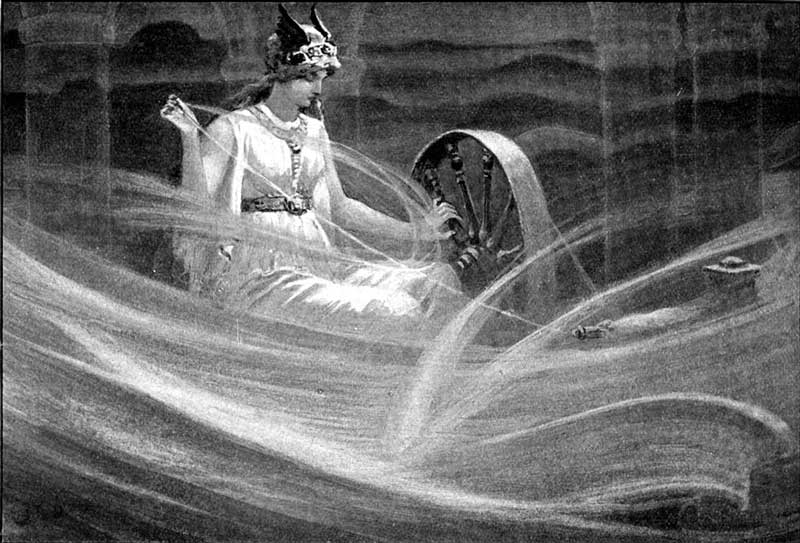
Goddess Frigga spinning clouds
Belief in demons and spirits (the cult of deceased ancestors) is widespread in Scandinavian myths. Demons include giants (jotuns, turs) and dwarfs ( miniatures), to the spirits - alves (elves), filgin (patron spirits of people, especially willingly appearing in the form of animals), eincheria (souls of warriors who fell in battle), valkyries (swan maidens) and others. However, the line between gods and demons is not drawn sharply. Even the main Scandinavian god, Odin, is descended from giants. Demonic character is also Loki , the god of fire and destruction, together with his three scary children : the wolf Fenrir, the serpent Jormungand and the goddess of death Hel. According to the original Scandinavian beliefs, all people (as well as those gods who were considered mortal, like Balder) fell into the kingdom of Hel. But the mythology of the Viking age created the idea of \u200b\u200ba paradise of warriors, Valhalle , the gates of which are opened for the heroes (Einheris) who fell in the battle, while those who died of old age or illness must descend into the dwelling of Hel. The sea god Aegir and his consort Rana are also close to demons; wise water spirit Mimir; the lord of the fiery world Surt, etc.
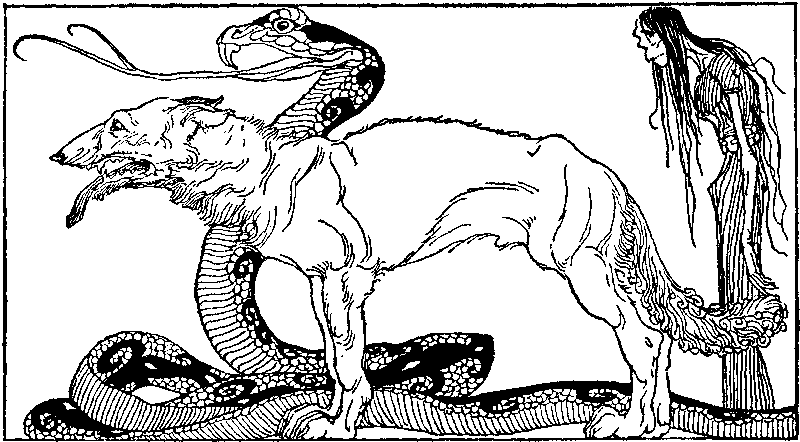
Loki's children - Fenrir, Jormungand and Hel
Scandinavian mythology has a developed cosmogony and eschatology (the doctrine of the end of the world). Creation myth is stated in it as follows. At the dawn of time there was neither heaven nor earth, but only a deserted, empty space, a kind of chaos (Ginungagap). At the northern end of it was formed Niflheim, the kingdom of fog and cold, and at the southern end, Muspellsheim, the world of fire and light. In Niflheim, there was the Hvergelmir ("Boiling Cauldron") spring, from which twelve streams poured out. The farther they were from their source, the more their waters froze: this is how frost and ice formed, filling the northern half of Ginungagap. But under the influence of the warm air of the south, the ice began to melt, and from the interaction of heat and cold, a humanoid creature arose, the mythical domir giant Ymir, from whom the generation of Khrimturs (frost giants) originated. At the same time, a cow, Audhumla, was born from the ice, and Ymir ate her milk. This cow licked salty ice blocks. By the evening of the first day, human hair appeared, the next day the head of a man, and on the third day and whole person, named Buri - the progenitor of the Scandinavian gods.
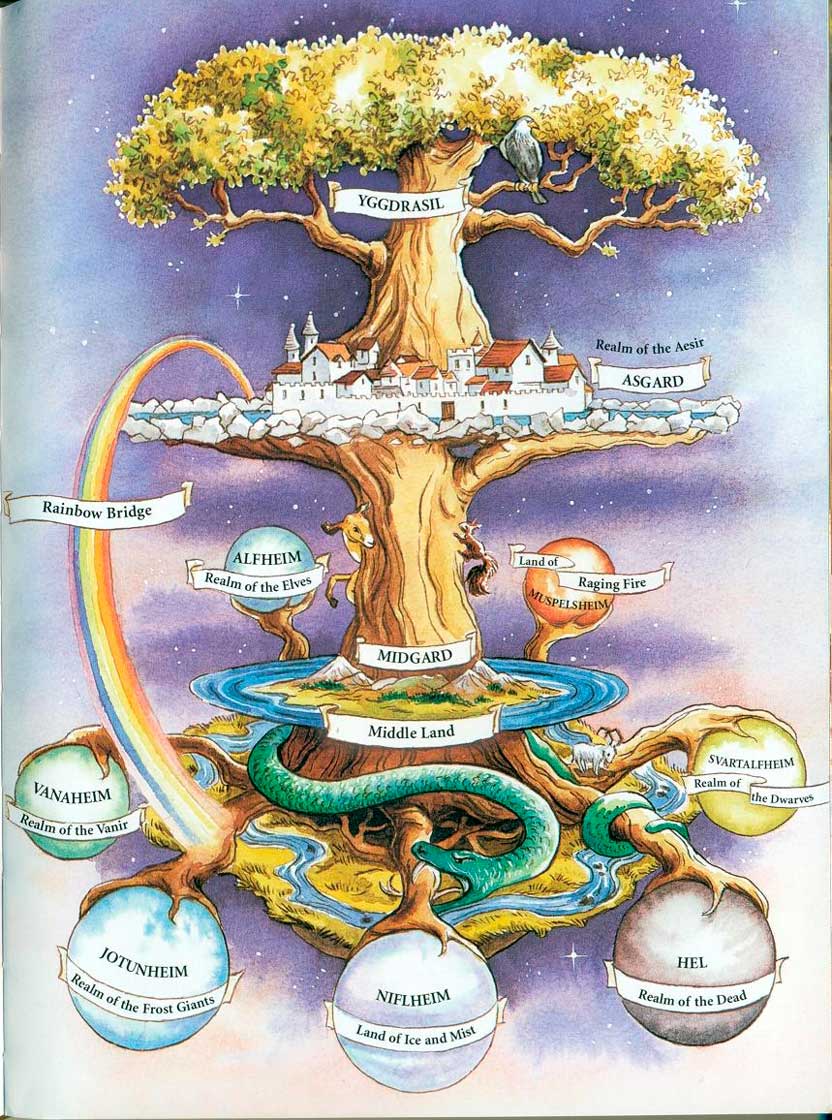
World ash Yggdrasil and nine worlds of Norse mythology (Asgard, Midgard, Alvheim and others)
The son of the Storm, the giant Bor, lived with the daughter of the giant Belthorn Bestla three sons: Odin, Vili and Ve. These were the gods-asses who received power over heaven and earth. Scandinavian myths describe how these three brothers killed the giant Ymir and created the universe out of him: from blood - water, from bones - mountains, from teeth - stones, from a skull - the sky, from hair - trees, from a brain - clouds. The sparks that flew from Muspellsheim were placed as luminaries (sun, moon and stars) in the firmament of heaven. The land was round and surrounded by a deep sea, on the coast of which (Jotunheim) giants settled. In defense of them scandinavian gods the fortress of Midgard ("The Middle Castle") was built from the eyebrows of Ymir.
On the seashore One with his brothers found two trees, from which they created two first humans, Asuka (ash) and Embloo (willow) ; their dwelling was Midgard. Scandinavian myths also tell about how the gods-brothers brought the universe into the device and placed charioteers in heaven sun and moon ... They ride in chariots, chased by huge wolves that threaten to devour them (solar and lunar eclipses). The divine beings of Day and Night were also settled in the sky, in order to go around the earth on fast horses every day. For themselves the gods built a palace in the sky










